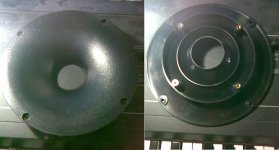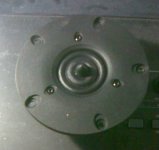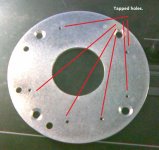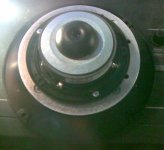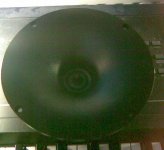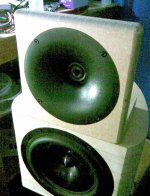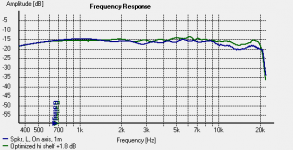I see, so still some way to go on the complete DSP7DAC package then.. Hope it doesn't drag out and get fraught with issues as my amp/x-over project did! But you seem to know what you're doing anyway.. 
Regarding generic calibration files, I really agree with you, wish there was a way I could check my mic without sending it off to proper calibration, something which would probably be many times more expensive than buying a new one of the more affordable type..like your ECM8000.
Yes, the Visit at SEAS was really great, we were given a tour by.. was it Tore Tambs Lyche..?, anyway, one of the really senior guys with a long history in the industry, lootss of info, both historical and technical, it was a real privilege!
Yes, that black Excell midrange is the last "odd job" I can remember seeing, but only at Madiound, nothing like that from the Norwegian distributor these days...
I agree that the standard SEAS line-up doesn't leave much to be wanted, but picking up some "exotic" special at a bargain price is something we all love, or what?
By the way, wasn't that black W15CH001 really a midrange??
Ah, the monacor waveguide.. still, will be very interresting to see how it turns out. But do you need to remove the faceplate from the tweeter?
My self, I'd be happy if I can get all the filling and veneer work done so I can have both my subwoofers finished and up & running soon!
Regarding generic calibration files, I really agree with you, wish there was a way I could check my mic without sending it off to proper calibration, something which would probably be many times more expensive than buying a new one of the more affordable type..like your ECM8000.
Yes, the Visit at SEAS was really great, we were given a tour by.. was it Tore Tambs Lyche..?, anyway, one of the really senior guys with a long history in the industry, lootss of info, both historical and technical, it was a real privilege!
Yes, that black Excell midrange is the last "odd job" I can remember seeing, but only at Madiound, nothing like that from the Norwegian distributor these days...
I agree that the standard SEAS line-up doesn't leave much to be wanted, but picking up some "exotic" special at a bargain price is something we all love, or what?
By the way, wasn't that black W15CH001 really a midrange??
Ah, the monacor waveguide.. still, will be very interresting to see how it turns out. But do you need to remove the faceplate from the tweeter?
My self, I'd be happy if I can get all the filling and veneer work done so I can have both my subwoofers finished and up & running soon!
I see, so still some way to go on the complete DSP7DAC package then.. Hope it doesn't drag out and get fraught with issues as my amp/x-over project did! But you seem to know what you're doing anyway..
Indeed, it's only taking a while because I am waiting for a response over on the TI engineering forums. I've got some ideas myself, I just want some confirmation/guidance before I go ahead and make another PCB.
Regarding generic calibration files, I really agree with you, wish there was a way I could check my mic without sending it off to proper calibration, something which would probably be many times more expensive than buying a new one of the more affordable type..like your ECM8000.
I don't remember who it was, but there used to be a guy who'd calibrate your ECM8000 (presumably he could do other mics too) if you sent it to him. You paid a small fee of course, but it wasn't outrageously expensive, more like the price of the mic itself, which considering the ECMs price, isn't too bad at all.
Yes, the Visit at SEAS was really great, we were given a tour by.. was it Tore Tambs Lyche..?, anyway, one of the really senior guys with a long history in the industry, lootss of info, both historical and technical, it was a real privilege!
Now you're really making me jealous
Yes, that black Excell midrange is the last "odd job" I can remember seeing, but only at Madiound, nothing like that from the Norwegian distributor these days...
By the way, wasn't that black W15CH001 really a midrange??
Sadly not, if it was I'd have snapped up a pair, even with the large shipping costs from the US. The specs were identical to this and as it stands, in my opinion, the W15CY001 is a superior driver. According to Zaphs measurement it's got ever so slightly less distortion in the area I am interested in and slightly higher sensitivity. In an ideal world, I'd like a hexadym magnet midrange of around 5" in diameter, with a light magnesium cone that has around ~90dB sensitivity re 8 ohm watt. Of course the break up would have to be as high as the W15CY001s, or ideally a little bit higher to keep the distortion peaks associated with that break up high enough up in frequency as to be as avoidable as possible.
Zaph Audios own ZA14 is pretty much what I'd have in mind, higher sensitivity, ever so slightly smaller radiating area, higher breakup and lower harmonic distortion. With a bit of refining in the direction of a dedicated midrange, I'm pretty sure the sensitivity could be increased by a couple more dBs. If I lived in the US I'd by a pair and give them a go, trouble is shipping from the US makes that a little prohibitive.
Other midrange drivers I'm interested in would be the midget little scan driver, the C173-6-090 from accuton, the 6ND430 from 18 sound and possibly the 15M/4624G00 from scan speak.
The accuton and the 18 sound driver both have brilliant specs and are sensitive too. The accuton is ridiculously priced though and over the 18 sound driver I cannot for any reason justify spending that much money on a driver, especially one as fragile as the accuton. The 18 sound is a pain in its own right though, a Square frame? Who the heck thought that was a good idea, these are a royal pain in the behind to flush mount.
The tiny 10f scan speak mid has some amazing numbers and if used right could sound fantastic, it's not too expensive either so that makes it even more attractive. The 15m on the other hand could be the better choice as its a bit more sensitive and should have far more low end capabilities. My only problem with the 15m is the impedance bobble at ~1500hz or so, lots of scan speak's relevelator drivers show this too and it doesn't affect the harmonic distortion at all, but I do not know if this carries on into the discovery drivers. If the 15M has distortion numbers like the 10F, it'd be one helluva midrange driver at a very attractive price point. Hopefully someone will get one to measure!
Ah, the monacor waveguide.. still, will be very interresting to see how it turns out. But do you need to remove the faceplate from the tweeter?
From this website it would appear so. The diameter of the ring dome appears to fit neatly inside the inner diameter of the wave-guide. I will have to see what's required when the WGs get here.
My self, I'd be happy if I can get all the filling and veneer work done so I can have both my subwoofers finished and up & running soon!
I detest 'finishing' loudspeakers >.< Yes I like the end product, but it's always so much work to make them look pretty and it's not the fun part of the work involved in designing a loudspeaker either!
Considering the effort and complexity, I can sure understand that you'd like to get those boards right first time arround! Just thinking about how much work it was just to make those boards for my amplifier project, and that ws simple one-sided stuff!
Apparently, Parts express has an affordable mic that comes with a calibration file, so I might pick one up next time i'm in the USA.. but then again.. perhaps I can live with a degree of uncertaintly in the top octave, after all my mic has proved to be usefull no end to sort out x-over frequencies and phase issues in the midrange, which is still way more than I could ever anticipate as a happy amateur only some years ago!
I agree that the new midranges from Scan-speak look very sexy,especially for the price! I'd definitively be looking in that direction my self if I were contemplating a 3-way system.
A hot tip regarding midrange by the way: SEAS G17REX/P or RE/P, officially obsolete from SEAS, but the norwegian SEAS dealer still stock the RE/P. It has a VERY nice midrange.
I have a couple of these in a pair of small boxes I threw together once which my brother is borowing.. I'm tempted to take them back and do something serious with them..
Get a cheap air ticket to somewhere in the US, have stuff shipped to your hotell address, buy losts of clothes (especially jeans), etc.. and before you know it, you have saved the fare!
Regardingfinishing, I'm not to fond of filling and priming as it seems to take forever between endles re-applications and is a right mess with sanding and dust everywhere.. But when the surfaces are finaly flat and the corners are sharp, I really enjoy laying down that veneer, not to mention seing the colour and glow of the wood come through as laquer or oil is applied!
Apparently, Parts express has an affordable mic that comes with a calibration file, so I might pick one up next time i'm in the USA.. but then again.. perhaps I can live with a degree of uncertaintly in the top octave, after all my mic has proved to be usefull no end to sort out x-over frequencies and phase issues in the midrange, which is still way more than I could ever anticipate as a happy amateur only some years ago!
I agree that the new midranges from Scan-speak look very sexy,especially for the price! I'd definitively be looking in that direction my self if I were contemplating a 3-way system.
A hot tip regarding midrange by the way: SEAS G17REX/P or RE/P, officially obsolete from SEAS, but the norwegian SEAS dealer still stock the RE/P. It has a VERY nice midrange.
I have a couple of these in a pair of small boxes I threw together once which my brother is borowing.. I'm tempted to take them back and do something serious with them..
Get a cheap air ticket to somewhere in the US, have stuff shipped to your hotell address, buy losts of clothes (especially jeans), etc.. and before you know it, you have saved the fare!
Regardingfinishing, I'm not to fond of filling and priming as it seems to take forever between endles re-applications and is a right mess with sanding and dust everywhere.. But when the surfaces are finaly flat and the corners are sharp, I really enjoy laying down that veneer, not to mention seing the colour and glow of the wood come through as laquer or oil is applied!
Last edited:
Considering the effort and complexity, I can sure understand that you'd like to get those boards right first time arround! Just thinking about how much work it was just to make those boards for my amplifier project, and that ws simple one-sided stuff!
Making the PCBs is no trouble, I've had the method solid for a number of years now. Throughout the years I've done around 7 different prototypes the PCM1794/92 DAC chips and never arrived at a performance level that I am happy with.
Apparently, Parts express has an affordable mic that comes with a calibration file, so I might pick one up next time i'm in the USA.. but then again.. perhaps I can live with a degree of uncertaintly in the top octave, after all my mic has proved to be usefull no end to sort out x-over frequencies and phase issues in the midrange, which is still way more than I could ever anticipate as a happy amateur only some years ago!
I don't think errors in the top octave area much to be too concerned about, although that's only if the mic has deviations that are around 1-2dB away from being accurate. I think the microphone that you're talking about is one that I've seen discussed over on the HT guide forums a number of times. From memory the calibration data is simply a piece of paper with a SPL graph on it. You could always take a picture of this with a digital camera then use SPL trace to create your own calib file, although I cannot remember if the calibration SPL graph was really any good in the first place!
I agree that the new midranges from Scan-speak look very sexy,especially for the price! I'd definitively be looking in that direction my self if I were contemplating a 3-way system.
I might end up buying one and giving it a measure, here's hoping someone else does first.
A hot tip regarding midrange by the way: SEAS G17REX/P or RE/P, officially obsolete from SEAS, but the norwegian SEAS dealer still stock the RE/P. It has a VERY nice midrange.
Mmm I've heard about that one and seen peoples favourable comments regarding it's mid-range.
not to mention seing the colour and glow of the wood come through as laquer or oil is applied!
This is the bit I am fond of too. I don't necessarily dislike finishing really, the bit I do not like is all the sanding required to get a mirror like shine. If an ultra smooth and reflective surface is not required then it isn't too bad.
As it stands the WG300 arrived earlier on today, so I'm going to go play some! The WG by the way is about 16.5cms in diameter so just a bit larger then a W15 and almost perfect in size to mate with a 6.5" driver - makes that damned accuton look even more attractive.
With regards to removing the XT25s faceplate, it doesn't look like this is necessary, although it would probably mate up particularly well if done this way too.
A few hours later and we have some success. The pictures are of bloody awful quality as the three digital cameras we've got are currently elsewhere >.< I had to make do with the camera built into a mobile phone, pfft.
The WG300 is actually very easy to work with and due to the mounting holes that are already embedded and tapped within the wave-guide itself, it makes mounting stuff to it very easy.
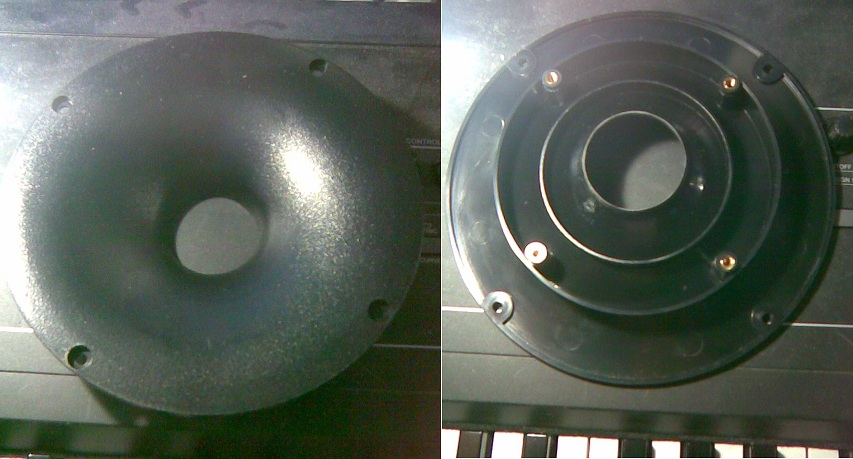
The throat of the wave-guide matches the diameter of the XT25s diaphragm extremely well and appears that it would also mate fairly well to a number of tweeters without too much issue, the only problem is securing the tweeter to the wave-guide.
To solve this I made a mounting plate out of 3mm thick aluminium, this is fixed to the wave-guide by the 4 holes already described. Then to secure the tweeter I tapped 6 3mm holes into the aluminium so that the tweeter could be screwed into place. 4 holes are for mounting the DXT and the extra 2 are for mounting the XT25.
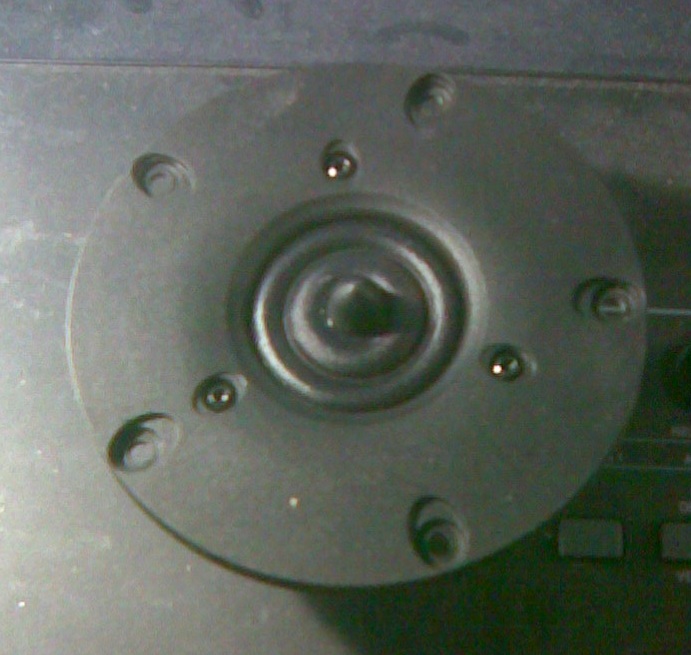
Three of the holes match up to the screw holes in the XT25s faceplate.
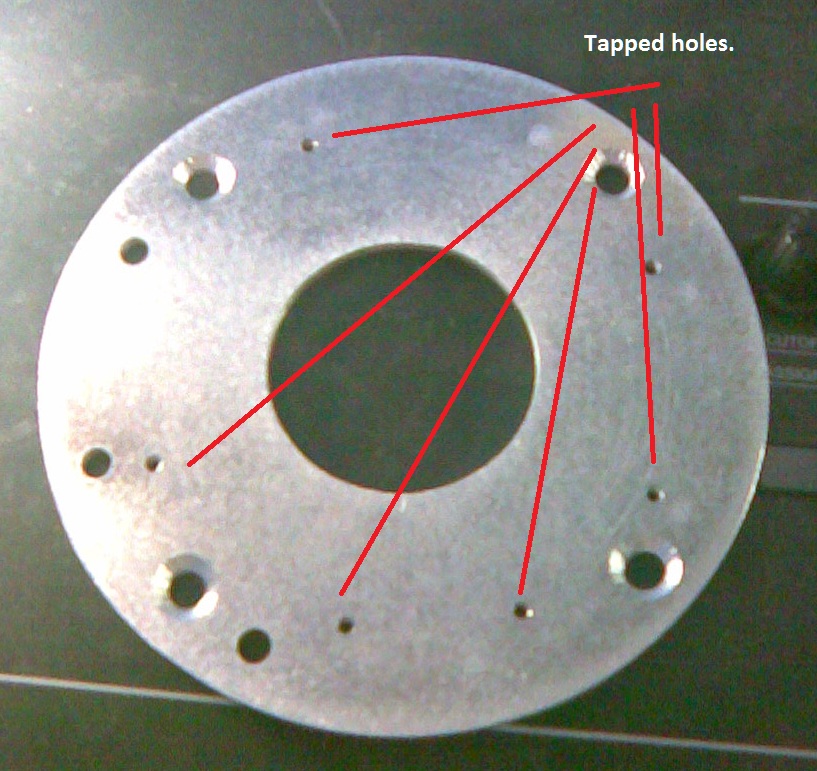
Now all that's left is to screw everything together and make sure everything is lined up.
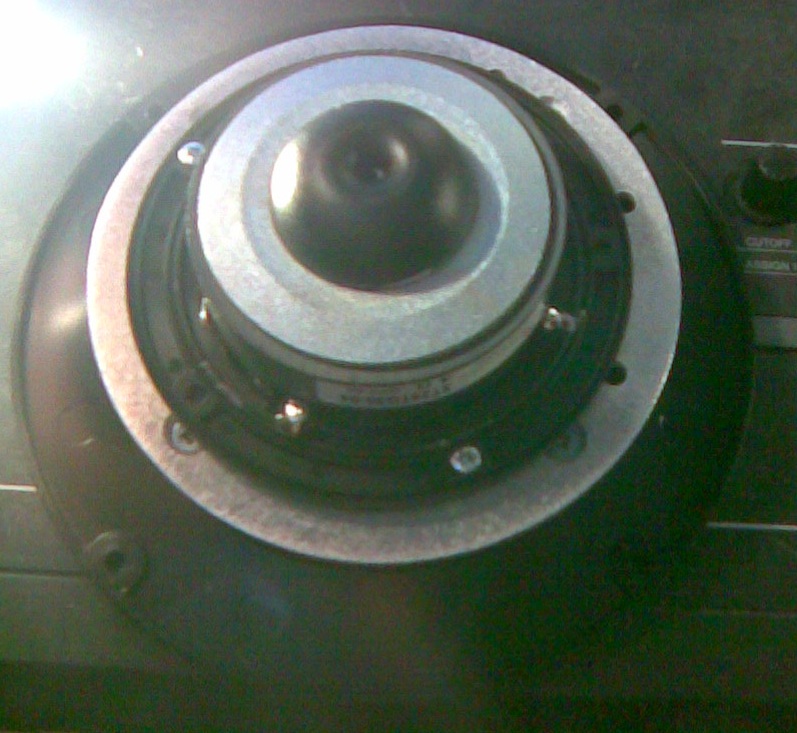
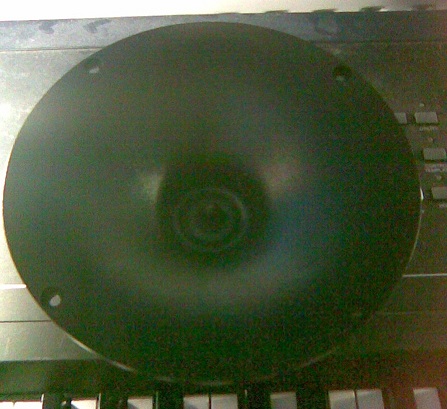
Complete with test baffle.
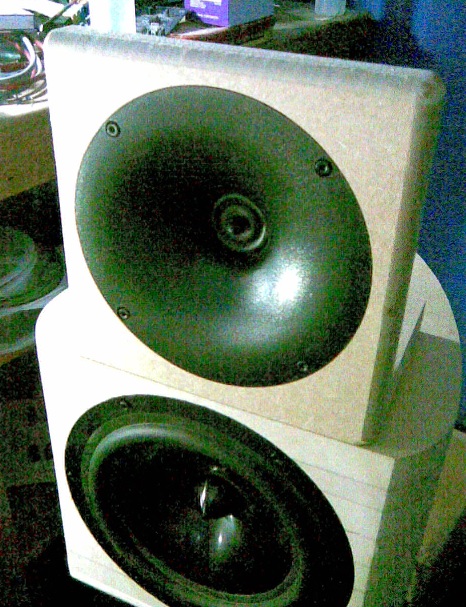
Using this method it would seem extremely easy to mate any tweeter to the WG300 without too much issue, just tap more mounting holes and you're set.
Due to the wave-guide already present on the DXT, the throat of the WG300 won't press directly up to the fine wire mesh in front of the DXTs dome. I don't know if this will have a huge impact on the measured performance, I shall have to do some measurements, they come next!
The tweeters I have my eye on that could make a wonderful combination would be these, they are already well known and well liked. Considering their performance, the two should mate up really well. The wave-guide giving a boost to the low frequency region and the tweeter already boasting extremely low distortion low down too. The only limitation to how low this could go, being the excursion limits of the tweeter itself.
The WG300 is actually very easy to work with and due to the mounting holes that are already embedded and tapped within the wave-guide itself, it makes mounting stuff to it very easy.
The throat of the wave-guide matches the diameter of the XT25s diaphragm extremely well and appears that it would also mate fairly well to a number of tweeters without too much issue, the only problem is securing the tweeter to the wave-guide.
To solve this I made a mounting plate out of 3mm thick aluminium, this is fixed to the wave-guide by the 4 holes already described. Then to secure the tweeter I tapped 6 3mm holes into the aluminium so that the tweeter could be screwed into place. 4 holes are for mounting the DXT and the extra 2 are for mounting the XT25.
Three of the holes match up to the screw holes in the XT25s faceplate.
Now all that's left is to screw everything together and make sure everything is lined up.
Complete with test baffle.
Using this method it would seem extremely easy to mate any tweeter to the WG300 without too much issue, just tap more mounting holes and you're set.
Due to the wave-guide already present on the DXT, the throat of the WG300 won't press directly up to the fine wire mesh in front of the DXTs dome. I don't know if this will have a huge impact on the measured performance, I shall have to do some measurements, they come next!
The tweeters I have my eye on that could make a wonderful combination would be these, they are already well known and well liked. Considering their performance, the two should mate up really well. The wave-guide giving a boost to the low frequency region and the tweeter already boasting extremely low distortion low down too. The only limitation to how low this could go, being the excursion limits of the tweeter itself.
Attachments
Now for the fun stuff the measurements.
First up is the XT25
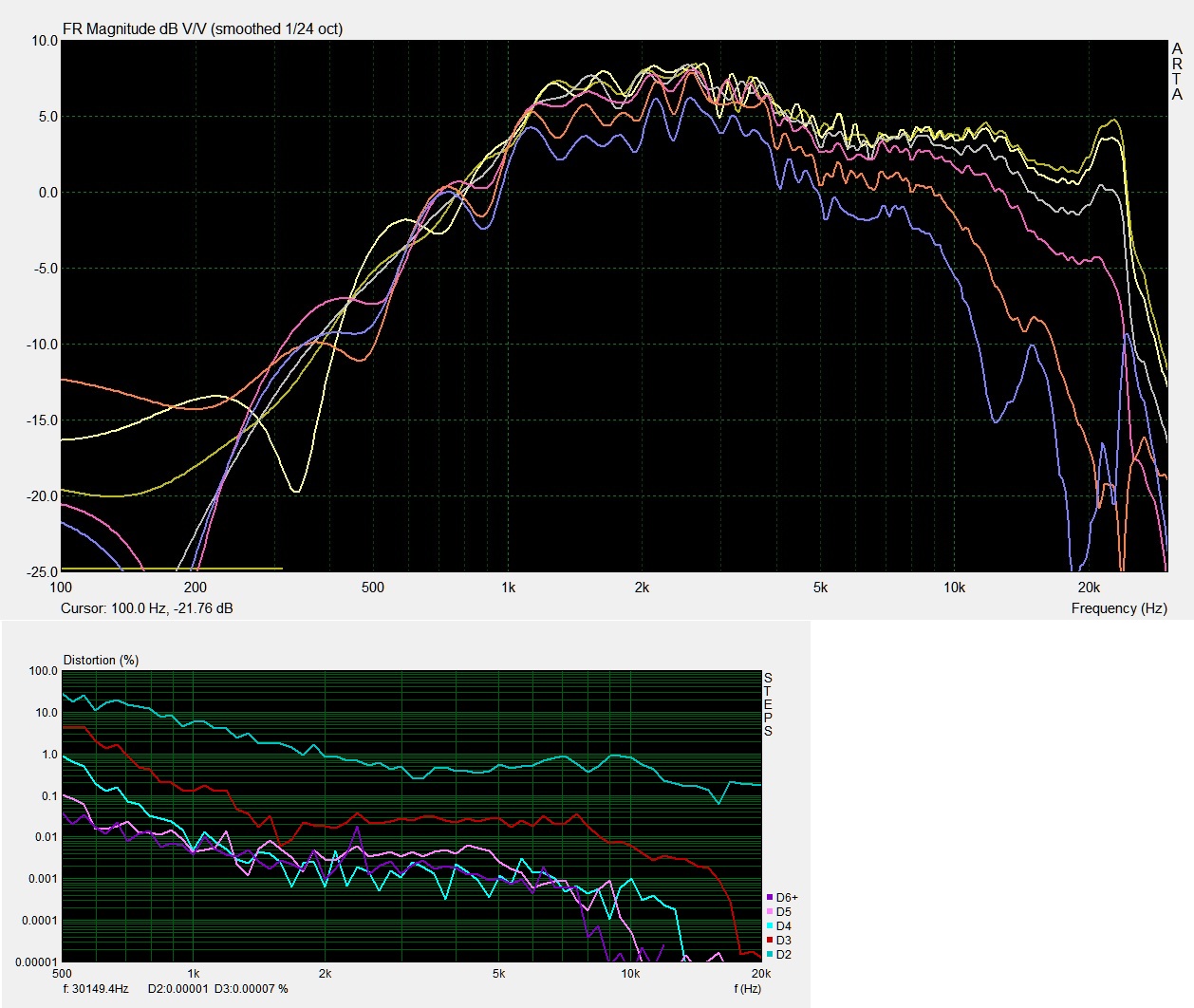
The first thing to notice is the very smooth response. All these measurements were taken in unfavourable conditions, so some small room reflections show up making the response a little ragged, but overall they are pretty decent.
Like this the XT25 also has very good distortion performance too, excellent 3rd, 4th, 5th and 6+. Only the rising second harmonic @ 3khz lets it down. I originally tried running the test @ 2.8 volts rms, the tweeter wasn't happy like this at all, something buzzed around 600-900 hz, not that the tweeter would be used down this low anyway, but I had to turn it down a little for it to be happy. Due to the extra output provided by the wave-guide you could probably get away with 1500hz 4th order slopes. The buzzing sound at 900hz was caused by the phase plug arrangement and might not be present in the scan speak versions with their better quality control.
Now for the DXT.
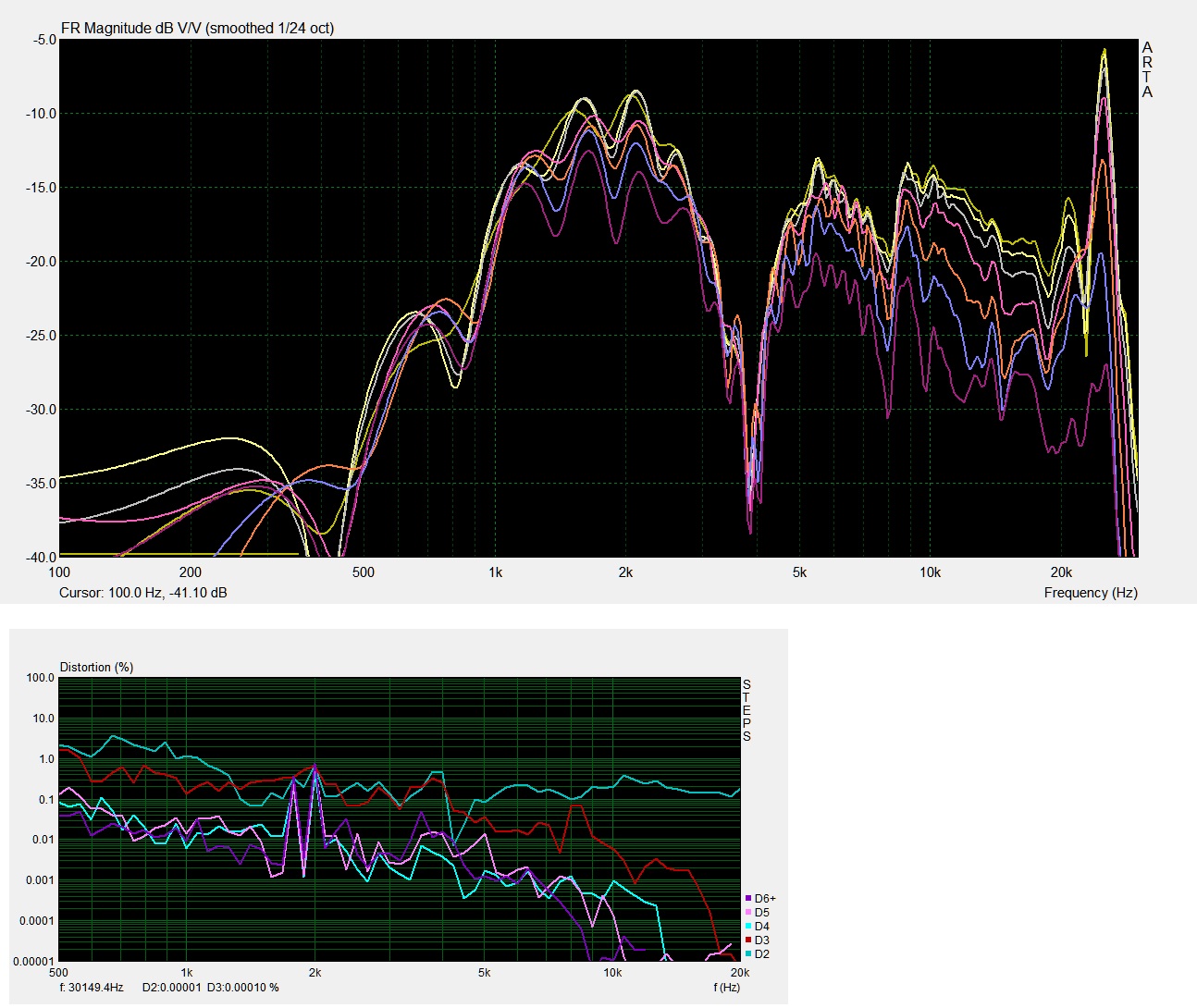
Shock!
I thought this might happen The spacing described above is obviously not anywhere close to being adequate, this creating a huge suck out centred on 4khz. Not much to say other then that, distortion performance looks nice though.
The spacing described above is obviously not anywhere close to being adequate, this creating a huge suck out centred on 4khz. Not much to say other then that, distortion performance looks nice though.
Out with the plasticine! DXT version 2.
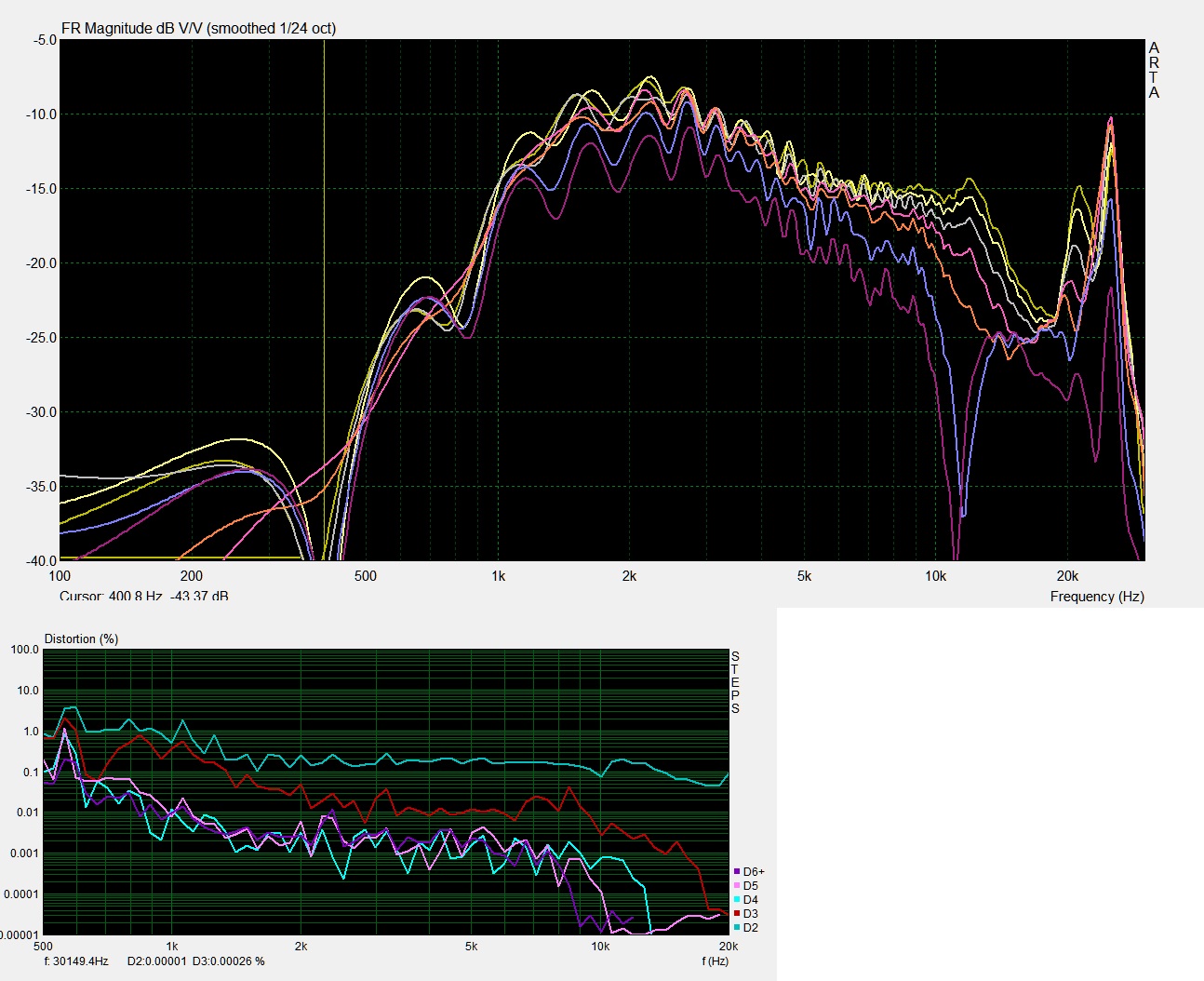
Ahhh much better. My 5 minute low tech filling in of the gap with plasticine has helped things considerably, the 4khz suck-out having vanished completely. Now however there's a dip in the top octave and as you go off axis another narrow suck-out appears. I am sure I could improve things considerably if I spent more time creating a better transition between the mesh grid and the wave-guide, currently it looks a bit like a 2 year old made it Distortion performance is excellent, it's clear that this is a better tweeter compared to the XT25. You might just be able to get away with a 1khz xover with 4th order slopes, this would have to be measured though to find out and I do intend on trying this out.
Distortion performance is excellent, it's clear that this is a better tweeter compared to the XT25. You might just be able to get away with a 1khz xover with 4th order slopes, this would have to be measured though to find out and I do intend on trying this out.
One thing that's interesting is the DXT distortion performance, here is a graph of the DXT in its own small wave-guide.
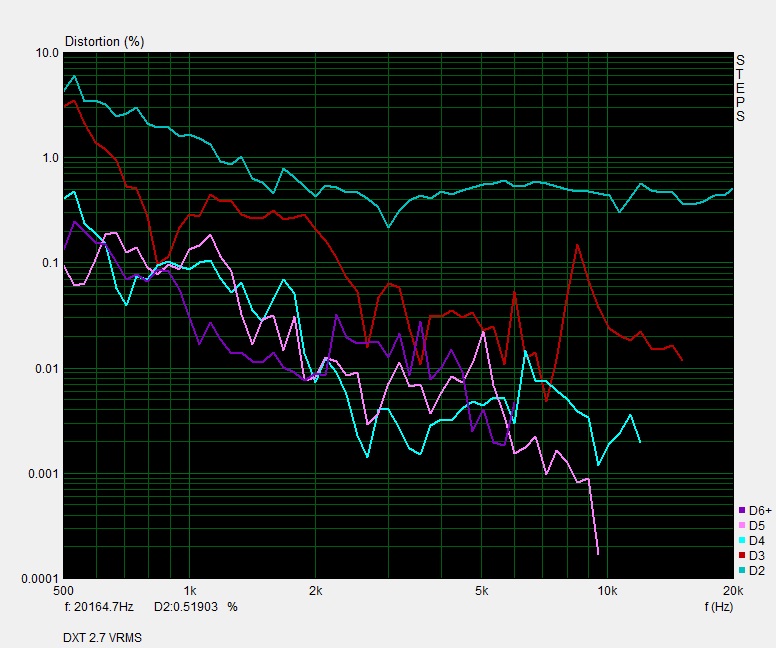
As can be seen there's a broad hump in the third harmonic around 1-2khz. This same hump can be seen in Zaphs measurements of the DXT too. However when using the WG300 instead of the DXTs own wave-guide this hump completely vanishes. I had assumed this was an issue with the motor/dome/chamber etc, but it appears like it's created by the wave-guide instead. Either that or the WG300 suppresses the peak.
The wave-guide appears to work rather well though, probably giving constant directivity down to around 2.5khz. The off axis curves can't really be directly compared as I didn't have a protractor around to give accurate angles, however the overall trend is easy to see. I probably went out to around 60 degrees.
This has me wanting to buy a pair of the scan tweeters I linked to before and trying those out. Tomorrow I'll probably pull some scan D2905/95s out of a finished design and test out those too.
First up is the XT25

The first thing to notice is the very smooth response. All these measurements were taken in unfavourable conditions, so some small room reflections show up making the response a little ragged, but overall they are pretty decent.
Like this the XT25 also has very good distortion performance too, excellent 3rd, 4th, 5th and 6+. Only the rising second harmonic @ 3khz lets it down. I originally tried running the test @ 2.8 volts rms, the tweeter wasn't happy like this at all, something buzzed around 600-900 hz, not that the tweeter would be used down this low anyway, but I had to turn it down a little for it to be happy. Due to the extra output provided by the wave-guide you could probably get away with 1500hz 4th order slopes. The buzzing sound at 900hz was caused by the phase plug arrangement and might not be present in the scan speak versions with their better quality control.
Now for the DXT.

Shock!
I thought this might happen
Out with the plasticine! DXT version 2.

Ahhh much better. My 5 minute low tech filling in of the gap with plasticine has helped things considerably, the 4khz suck-out having vanished completely. Now however there's a dip in the top octave and as you go off axis another narrow suck-out appears. I am sure I could improve things considerably if I spent more time creating a better transition between the mesh grid and the wave-guide, currently it looks a bit like a 2 year old made it
One thing that's interesting is the DXT distortion performance, here is a graph of the DXT in its own small wave-guide.

As can be seen there's a broad hump in the third harmonic around 1-2khz. This same hump can be seen in Zaphs measurements of the DXT too. However when using the WG300 instead of the DXTs own wave-guide this hump completely vanishes. I had assumed this was an issue with the motor/dome/chamber etc, but it appears like it's created by the wave-guide instead. Either that or the WG300 suppresses the peak.
The wave-guide appears to work rather well though, probably giving constant directivity down to around 2.5khz. The off axis curves can't really be directly compared as I didn't have a protractor around to give accurate angles, however the overall trend is easy to see. I probably went out to around 60 degrees.
This has me wanting to buy a pair of the scan tweeters I linked to before and trying those out. Tomorrow I'll probably pull some scan D2905/95s out of a finished design and test out those too.
Wow, great stuff 5th! 
First of all, What about starting a new thread on this and moving these latest posts?
I think your experiments and measurements deserves a thread of their own rather than having it alll burried deep in some old thread which has now deviated considerably from the original theme.
This would of course allso make it easier for other people to find and make use of what's being posted!
The XT25 certainly looks promising, hope it is easy to smooth out to flat with a "standard" filter slope too!
But why would you add the waveguide to the DXT tweeter?? That would sort of be a waste of the DXT waveguide/ lens allready in place.
Funny, I actually have a pair of the D2608/913000 on the shelf, bouthg them on impulse but then later decided to go for the DXT tweeter for my project..And since I allready have them, it would make good sense to try them for a future wave-guide/ CD project.
If it hadn't been for the relatively expensive shipping, I would have been happy to lend them to you for some testing!
The short time i tried them, they did sound very nice, perhaps a touch bright in the top, you might say they made their precence somewhat more known than the very neutral sounding DXT tweeters, allbeit not in any objectionable way.
Very good mounting description by the way, and a nice adapter! Do you have access to a lathe or something?
Will be very interresting to see what the result will be with the D2905/95s when you get arround to it!
Im particularilly curious about what difference there will be between a phase-plug/ ring radiator design and a "conventional" high quality dome, so it will be great to have a comparison with the same equipment, not to mention any subjective listening impressions you might provide!
Oh, what's that midwoofer unit I could see in some of the pictures by the way?
First of all, What about starting a new thread on this and moving these latest posts?
I think your experiments and measurements deserves a thread of their own rather than having it alll burried deep in some old thread which has now deviated considerably from the original theme.
This would of course allso make it easier for other people to find and make use of what's being posted!
The XT25 certainly looks promising, hope it is easy to smooth out to flat with a "standard" filter slope too!
But why would you add the waveguide to the DXT tweeter?? That would sort of be a waste of the DXT waveguide/ lens allready in place.
Funny, I actually have a pair of the D2608/913000 on the shelf, bouthg them on impulse but then later decided to go for the DXT tweeter for my project..And since I allready have them, it would make good sense to try them for a future wave-guide/ CD project.
If it hadn't been for the relatively expensive shipping, I would have been happy to lend them to you for some testing!
The short time i tried them, they did sound very nice, perhaps a touch bright in the top, you might say they made their precence somewhat more known than the very neutral sounding DXT tweeters, allbeit not in any objectionable way.
Very good mounting description by the way, and a nice adapter! Do you have access to a lathe or something?
Will be very interresting to see what the result will be with the D2905/95s when you get arround to it!
Im particularilly curious about what difference there will be between a phase-plug/ ring radiator design and a "conventional" high quality dome, so it will be great to have a comparison with the same equipment, not to mention any subjective listening impressions you might provide!
Oh, what's that midwoofer unit I could see in some of the pictures by the way?
Wow, great stuff 5th!
First of all, What about starting a new thread on this and moving these latest posts?
I'm not quite ready to start a new post with things yet. I need to get the DSP working with all 8 channels before I can make any subjective conclusions and investigate how best to use/integrate the wave-guide. I also want to post a specific type of measurement that require a very precise measurement technique with respect to the off axis.
Here is the d2905/95
It works rather well. Here it is hammered flat with the DSP + a 4th order acoustic LWR filter.
This still looks very nice. The tweeter wasn't happy using a 1khz xover, moving it up to 1.5k was possibly useable depending on how loud you want things to be. Mind you I wear ear defenders when doing distortion tests as it hurts otherwise, so I guess it can prolly go loud enough at 1.5k.
The only issue I can see is the bunching up of the off axis response @ 16/17khz. I don't think this is enough to make anything sound bad, it might add a touch of brightness.
The XT25 certainly looks promising, hope it is easy to smooth out to flat with a "standard" filter slope too!
The d2905/95 required three notches in combination with a 4th order electrical filter to get it flat, the XT on the other hand does this with only 2 notches, one these also only works at 10k+ and by a small amount, so it might not actually be needed.
But why would you add the waveguide to the DXT tweeter?? That would sort of be a waste of the DXT waveguide/ lens allready in place.
The idea was to use the DXT's motor + dome in conjunction with the WG300, effectively bypassing its own wave-guide completely. This did not work very well, even faffing about with the plasticine wouldn't get the top octave to come together, and although it did improve things a bit, it made the 5k region a bit lumpy.
Funny, I actually have a pair of the D2608/913000 on the shelf, bouthg them on impulse but then later decided to go for the DXT tweeter for my project..And since I allready have them, it would make good sense to try them for a future wave-guide/ CD project.
I'm going to hold off on buying any more tweeters until I've properly evaluated the wave-guide with the ones I've got. Between the D2905 and the XT, I should be able to draw some decent conclusions.
If it hadn't been for the relatively expensive shipping, I would have been happy to lend them to you for some testing!
Shipping can be a damned pain sometimes!
The short time i tried them, they did sound very nice, perhaps a touch bright in the top, you might say they made their precence somewhat more known than the very neutral sounding DXT tweeters, allbeit not in any objectionable way.
I think this has been said about them elsewhere too, they've got a very lively top end. The good thing about the wave-guide is that it should give every similar 1" dome tweeter, providing they mount to it successfully, roughly the same off axis response, making them perhaps easier to compare.
Very good mounting description by the way, and a nice adapter! Do you have access to a lathe or something?
Nah, a lathe would be nice, but we don't have the space for one really. I did all of that with the circle cutter on the router.
Will be very interresting to see what the result will be with the D2905/95s when you get arround to it!
See above
Im particularilly curious about what difference there will be between a phase-plug/ ring radiator design and a "conventional" high quality dome, so it will be great to have a comparison with the same equipment, not to mention any subjective listening impressions you might provide!
I am interested in this too, I must get the other DAC channels finished
Oh, what's that midwoofer unit I could see in some of the pictures by the way?
It's an RS225, it's an 8", which shows that the WG300 is pretty large 170mm diameter.
Having stereo = 2 channels is kind of limiting, but I didn't let it hold me back. I tried a quick mono 2 way using the XT and the RS225. I crossed them at 1500hz 4th order. The frequency response was flat as a pancake and phase integration was excellent. The distortion was also very low at the levels I was listening at. It did not sound good though, something was melting my ears off. I tried playing the piano (synthogy Ivory2 grand ) through it and noticed that certain notes made my ears jump and want to hide away, this doesn't occur on the headphones and hadn't on the previous analogue active xover. I got the spectrum analyser of ARTA out and found that the objectionable content was centred around 3-5khz. I am not entirely sure what this could be. I am currently rebuilding the cabinets and the translam for the W15s aren't done yet, I really need them done I think to make any realistic conclusions though.
The RS225 has a peak in the distortion plot at 1.5khz, and while not really that high, it could be contributing to it. There's a spike in the third harmonic there and any 1.5-1.8khz stuff will excite this giving output in the 4-5khz range. The relative level of the distortion is still low mind you so I am not convinced that's the issue. Using the W15 will be an easy way to see if this is the cause. Also the XT would prefer being used a bit higher, at least 1.8khz or so.
The measurements I've done don't really describe why I am hearing what I am, but something has to account for it.
Summer has passed, and with a wet and cold autumn, it's back to stereo projects again!
Today, I perfected my stereo set-up.
Not long ago, I finished my subwoofer project, and after some level fine-tuning, I got a very flat response in my listening position down to about 30 Hz and and a very controlled and deep bass reproduction.
http://www.diyaudio.com/forums/subwoofers/199009-completed-build-inspiration.html
At the end of the above thread, you can see the in-room measurement. As you can see, there si a considerable droop in HF response, but bear in mind that this is the listening position, not a gated on-axis measurement.
Still, I felt that a lot of recordings missed some detail and life.
did a measurement without the HF equalisation as input to LSPCAD and ran some optimalisations. No huge changes, merely a 2 dB boost at 15k and about 0,8 dB at 5k relative to what I was allready running.
Modified the filters and put them back in; Perfect! Now there is no feeling of anything missing, and yet no signs of excessive HF or listening fatigue. things finally came together.
Enclosed, you can see measurements before and after this last tweak. Obviously not dramatic, but this was all it took to get it right!
(Bear in mind that as my mick is home-buildt running a "generic" calibration file, the measurements are not absolute in the upper frequencies.)
Apart from seriously brushing up on my electronics, this project has been a very good excercise in how to combine critical listening, measurements and the use of tools like LSPCAD to acheive results which goes well beyound what I expected in the eraly days of this project.
A final thanks to all that contributed!!
Today, I perfected my stereo set-up.
Not long ago, I finished my subwoofer project, and after some level fine-tuning, I got a very flat response in my listening position down to about 30 Hz and and a very controlled and deep bass reproduction.
http://www.diyaudio.com/forums/subwoofers/199009-completed-build-inspiration.html
At the end of the above thread, you can see the in-room measurement. As you can see, there si a considerable droop in HF response, but bear in mind that this is the listening position, not a gated on-axis measurement.
Still, I felt that a lot of recordings missed some detail and life.
did a measurement without the HF equalisation as input to LSPCAD and ran some optimalisations. No huge changes, merely a 2 dB boost at 15k and about 0,8 dB at 5k relative to what I was allready running.
Modified the filters and put them back in; Perfect! Now there is no feeling of anything missing, and yet no signs of excessive HF or listening fatigue. things finally came together.
Enclosed, you can see measurements before and after this last tweak. Obviously not dramatic, but this was all it took to get it right!
(Bear in mind that as my mick is home-buildt running a "generic" calibration file, the measurements are not absolute in the upper frequencies.)
Apart from seriously brushing up on my electronics, this project has been a very good excercise in how to combine critical listening, measurements and the use of tools like LSPCAD to acheive results which goes well beyound what I expected in the eraly days of this project.
A final thanks to all that contributed!!
Attachments
You know it was by shear luck that I found this updated and only a day after you'd posted too! Often small changes in the high frequencies are not performance breaking but they do add the icing to the proverbial cake. I know I am quite sensitive to high frequency tuning, too much tilt upwards and it's too much, too little and all the sparkle goes away, some tweeters seem to sparkle more easily then others, whereas some sound gritty and dirty with too much high frequency energy going on and you can never strike the right balance.
Interestingly it's the wave-guides I've found that help keep a tweeter sounding effortless, clean and scintillating in the last octave. Even with the wave-guides it is still all to easy to have the tweeter level set a step too high and once that happens the balance is way too in your face.
It's nice to see that you've created a build thread too Everyone loves pictures of progress/finished systems.
Everyone loves pictures of progress/finished systems.
The RS subs I bet were the very nice way to top everything off. Those drivers do strike a nice balance between performance and value for money. I did entertain the idea of putting two 12" RS subs into a large ported cabinet, but gave up on that idea when I realised how much of the room it would take up! I'll stick to my 12" cubes + XLS10 for the time being.
And the neighbours be damned, I bet you love finding music with monster bass and cranking it up
Interestingly it's the wave-guides I've found that help keep a tweeter sounding effortless, clean and scintillating in the last octave. Even with the wave-guides it is still all to easy to have the tweeter level set a step too high and once that happens the balance is way too in your face.
It's nice to see that you've created a build thread too
The RS subs I bet were the very nice way to top everything off. Those drivers do strike a nice balance between performance and value for money. I did entertain the idea of putting two 12" RS subs into a large ported cabinet, but gave up on that idea when I realised how much of the room it would take up! I'll stick to my 12" cubes + XLS10 for the time being.
And the neighbours be damned, I bet you love finding music with monster bass and cranking it up
Wow, 5th! 
Long time, fun to have you post a reply on this old thread just after I "revived" it!
I must admit I was starting to think something was wrong somewhere else.. which was startign to get a bit dissapointing, considering I went for 3 way active, expensive and high quality drivers etc... and all it took was adding those few decibels to the top 1-2 octaves! I must admitt I was surprised..
I don't have the same base of reference as you do, but the high frequencies are definitively effortless, so at the end of the day, it was probably a good move to stick to thoose DXT tweeters even with all the trouble I had equalizing them properly!
I agree, good build threads are allways interresting and inspiring, so i decided to do one my self!
I am pleased no end with these subwoofers, even If I might come to tweak other parts of the system in the future, I don't see my self changing the subs. The only excemption I can think of is if I one day find my self well off with a big house and very large living room, then I might go for full size sub-horns!
Fortunately, my landlord (I rent a falt in a private house) is retired and often away to India, hope he's leaving again soon so I can really let loose!
I do find that much of the music I have don't really excercise the subs that much, but whatever bass there is in any recording gets faithfully reproduced in a very pleasing manner. A few records come out way boomy, an indication that the bass monitoring during mixdown was not good enough. Then there are those few recordings which really has high-quality low frequency information... oh joy!
How are you doing with the multiple sub and DSP projects by the way?
Long time, fun to have you post a reply on this old thread just after I "revived" it!
I must admit I was starting to think something was wrong somewhere else.. which was startign to get a bit dissapointing, considering I went for 3 way active, expensive and high quality drivers etc... and all it took was adding those few decibels to the top 1-2 octaves! I must admitt I was surprised..
I don't have the same base of reference as you do, but the high frequencies are definitively effortless, so at the end of the day, it was probably a good move to stick to thoose DXT tweeters even with all the trouble I had equalizing them properly!
I agree, good build threads are allways interresting and inspiring, so i decided to do one my self!
I am pleased no end with these subwoofers, even If I might come to tweak other parts of the system in the future, I don't see my self changing the subs. The only excemption I can think of is if I one day find my self well off with a big house and very large living room, then I might go for full size sub-horns!
Fortunately, my landlord (I rent a falt in a private house) is retired and often away to India, hope he's leaving again soon so I can really let loose!
I do find that much of the music I have don't really excercise the subs that much, but whatever bass there is in any recording gets faithfully reproduced in a very pleasing manner. A few records come out way boomy, an indication that the bass monitoring during mixdown was not good enough. Then there are those few recordings which really has high-quality low frequency information... oh joy!
How are you doing with the multiple sub and DSP projects by the way?
The DSP is at pretty much the same stage as before. I am still trying to solve the same problem! My health unfortunately slows things down a little but that doesn't stop me, I just take a bit longer to get there.
I don't think any music will really put much of a strain on the subs. Two 15" drivers in large cabinets will have some real maximum SPL capability, I'd be surprised if they couldn't hit 105dB at 20hz whilst staying within rated Xmax.
My multiple subs are coming along decently, in fact I'll turn them on properly for the first time later on today! I got the DSP sorted out for them yesterday and today some bits arrived from Farnell to allow me to finish some amplifiers, time for fun!
I don't think any music will really put much of a strain on the subs. Two 15" drivers in large cabinets will have some real maximum SPL capability, I'd be surprised if they couldn't hit 105dB at 20hz whilst staying within rated Xmax.
My multiple subs are coming along decently, in fact I'll turn them on properly for the first time later on today! I got the DSP sorted out for them yesterday and today some bits arrived from Farnell to allow me to finish some amplifiers, time for fun!
Funny enough, the simulations I did with the subwoofer predicts excactly the same as you mention!  And yes, I think that should cover my low frequency reproduction requirements for the forseeable future!
And yes, I think that should cover my low frequency reproduction requirements for the forseeable future! 
Hope you are doing OK, and that there's nothing to serious with your health! Annyway, some good audio projects to play arround with is a good way to get some positive focus and take the mind of things, I've found that out my self!
Well, a grand evening for you then ,I'm excited to hear what the result will be!
Hope you are doing OK, and that there's nothing to serious with your health! Annyway, some good audio projects to play arround with is a good way to get some positive focus and take the mind of things, I've found that out my self!
Well, a grand evening for you then ,I'm excited to hear what the result will be!
Ah my health issues are chronic unfortunately although rather limiting I can still do the DIY thing it just takes a lot out of me most of the time.
I had a bit of a play with the multiple subs using a TAS5630 as the main amp for them. Supposedly its best to use one main sub to do the grunt work, then have two other smaller ones left to fill in the gaps and smooth out some peaks that the main sub + main loudspeakers leave.
As I've only got two amplifier channels, that left me with a bit of a problem, although I do have plenty of DSP up my sleeve to help manage things. So far I've got two XLS cubes acting as the 'main sub' and both driven from one channel of amplification. The other two are positioned in different places, but again wired in parallel to the other channel. The RS225s I left covering down to 35hz with a highpass @ the same frequency giving a 4th order roll off centred at 35hz.
Considering the benefit of multiple subs is having lots of drivers covering the same range I wondered how you avoided getting a peak in the response where the mains and the main sub overlap... To this end I've applied a complex array of shelving filters to all of the subs and the mains. The main shelves turn down the mains and main sub and blend them together so that I don't get a hump. The other shelving filters bring in the secondary subs at a lower level to help fill in gaps. Of course it didn't end there. As I wanted to get the most max SPL capability down below where the room stops being modal I added in shelving filters that blend all of the subs together, so that by 20hz they are all working as hard as one another.
So in other words I get generous overlap between the mains and the main sub. The other two subs fill in gaps somewhat and then I merge all the subs together for maximum output at 20hz.
I ended up with around +-5dB at the listening position with a bit more faffing I will probably get it better. I do want to try out splitting the main sub though, so I've got what would be 'stereo' subs, instead of one main sub. I don't see any disadvantage to doing that.
Music sounds great, wonderful bass! No boom, no notes that stick out, no notes that seem to be non existent. Measurements imply I've got it flat down to something like 15hz with a slow roll of below. I did watch The Incredibles earlier on today and that really sounded fantastic too. You really appreciate the extra oopmh down at 20hz if you've never had it before and I will certainly be watching all of my movies over the next few days I think. Open baffles with the XLS did sound good, but this sounds better and has more output and requires less power when dong so. It's also less intrusive visually. I guess you could call me one happy DIYer.
Now I just need to properly finish of the DSP and build the new cabinets for the tweeter+ mid.
I had a bit of a play with the multiple subs using a TAS5630 as the main amp for them. Supposedly its best to use one main sub to do the grunt work, then have two other smaller ones left to fill in the gaps and smooth out some peaks that the main sub + main loudspeakers leave.
As I've only got two amplifier channels, that left me with a bit of a problem, although I do have plenty of DSP up my sleeve to help manage things. So far I've got two XLS cubes acting as the 'main sub' and both driven from one channel of amplification. The other two are positioned in different places, but again wired in parallel to the other channel. The RS225s I left covering down to 35hz with a highpass @ the same frequency giving a 4th order roll off centred at 35hz.
Considering the benefit of multiple subs is having lots of drivers covering the same range I wondered how you avoided getting a peak in the response where the mains and the main sub overlap... To this end I've applied a complex array of shelving filters to all of the subs and the mains. The main shelves turn down the mains and main sub and blend them together so that I don't get a hump. The other shelving filters bring in the secondary subs at a lower level to help fill in gaps. Of course it didn't end there. As I wanted to get the most max SPL capability down below where the room stops being modal I added in shelving filters that blend all of the subs together, so that by 20hz they are all working as hard as one another.
So in other words I get generous overlap between the mains and the main sub. The other two subs fill in gaps somewhat and then I merge all the subs together for maximum output at 20hz.
I ended up with around +-5dB at the listening position with a bit more faffing I will probably get it better. I do want to try out splitting the main sub though, so I've got what would be 'stereo' subs, instead of one main sub. I don't see any disadvantage to doing that.
Music sounds great, wonderful bass! No boom, no notes that stick out, no notes that seem to be non existent. Measurements imply I've got it flat down to something like 15hz with a slow roll of below. I did watch The Incredibles earlier on today and that really sounded fantastic too. You really appreciate the extra oopmh down at 20hz if you've never had it before and I will certainly be watching all of my movies over the next few days I think. Open baffles with the XLS did sound good, but this sounds better and has more output and requires less power when dong so. It's also less intrusive visually. I guess you could call me one happy DIYer.
Now I just need to properly finish of the DSP and build the new cabinets for the tweeter+ mid.
Sorry to hear that you are struggling with chronic illness 5th, but at the same time good to know that it's not stopping you from pursuing the DIY hobby at a rather advanced level! 
Wow, sounds like things really came together with your subwoofer set-up! Down to 15 HZ?! Well, that should be sufficient even for large marine mammals!
+/- 5dB at listening position is just impressive, especially considering how low your system goes! I'd take that as solid proof of concept for multiple subs!
Sounds like good fun to re-discover your film collection like that! I was kind of hoping to do the same with my record-collection, but it turned out that my new grand Hi-fi system was just as apt at revealing how poor many of my recordings were!
I was kind of hoping to do the same with my record-collection, but it turned out that my new grand Hi-fi system was just as apt at revealing how poor many of my recordings were! 
What sort of cabinetts will you do for the tweeter/mids?
I think my next step, yes I'm there allreeady, will be to put the subwoofer amplifiers in to separate cabinets, and build a separate box for the active filters. This to redyce the thermal challenge of my current 3-channel amps. The heatsinking is marginal and the noise from the coling fans (hopefully to be done away with) are not acceptable in the long run. Allso removing the filter cards from the amplifiers should remove the issue with hum and noise due to the proximity to the big 600 VA toroids.
Wow, sounds like things really came together with your subwoofer set-up! Down to 15 HZ?! Well, that should be sufficient even for large marine mammals!
+/- 5dB at listening position is just impressive, especially considering how low your system goes! I'd take that as solid proof of concept for multiple subs!
Sounds like good fun to re-discover your film collection like that!
What sort of cabinetts will you do for the tweeter/mids?
I think my next step, yes I'm there allreeady, will be to put the subwoofer amplifiers in to separate cabinets, and build a separate box for the active filters. This to redyce the thermal challenge of my current 3-channel amps. The heatsinking is marginal and the noise from the coling fans (hopefully to be done away with) are not acceptable in the long run. Allso removing the filter cards from the amplifiers should remove the issue with hum and noise due to the proximity to the big 600 VA toroids.
What sort of cabinetts will you do for the tweeter/mids?
Something a little out of the ordinary
I think my next step, yes I'm there allreeady, will be to put the subwoofer amplifiers in to separate cabinets, and build a separate box for the active filters. This to redyce the thermal challenge of my current 3-channel amps. The heatsinking is marginal and the noise from the coling fans (hopefully to be done away with) are not acceptable in the long run. Allso removing the filter cards from the amplifiers should remove the issue with hum and noise due to the proximity to the big 600 VA toroids.
Have you considered simply moving the 600VA toroids into their own separate chassis and leaving the rest where they are? That should free up space to possibly increase the amount of heat-sinking you can use in the main chassis. Moving the toroid would also remove the magnetic fields that seem to be causing you trouble.
If you do decide on moving the transformers to a separate chassis do keep the rectification and smoothing caps inside the main chassis.
Ah, nothing like a good surprise 5th!  Looking very much forward to that upcomming mystery thread of yours!
Looking very much forward to that upcomming mystery thread of yours! 
Regarding your Idea about putting the Toroids in to a separate chassis, you are on to something there regarding the hum and interference problems, that would solve that one quite effectively I would say.
Then there is the issue of cooling,.. even with the toroids out, the scope for stuffing in some larger heatsings would be limited..unfortunately..
My best bet would perhaps be to get some larger chassis, with enough room to place the toroids sensibly, larger heatsinks (perhepaps external) and room to place the filter-cards well out of harms way?
Regarding your Idea about putting the Toroids in to a separate chassis, you are on to something there regarding the hum and interference problems, that would solve that one quite effectively I would say.
Then there is the issue of cooling,.. even with the toroids out, the scope for stuffing in some larger heatsings would be limited..unfortunately..
My best bet would perhaps be to get some larger chassis, with enough room to place the toroids sensibly, larger heatsinks (perhepaps external) and room to place the filter-cards well out of harms way?
- Status
- This old topic is closed. If you want to reopen this topic, contact a moderator using the "Report Post" button.
- Home
- Source & Line
- Analog Line Level
- Shelving 2nd order high-pass?
